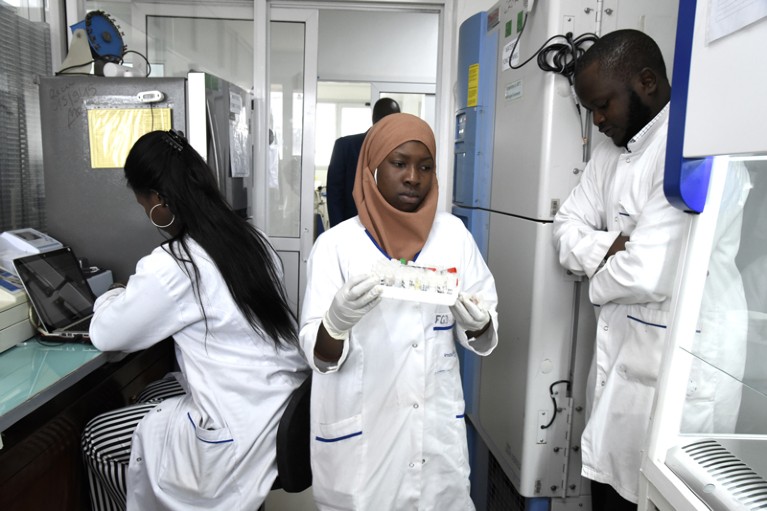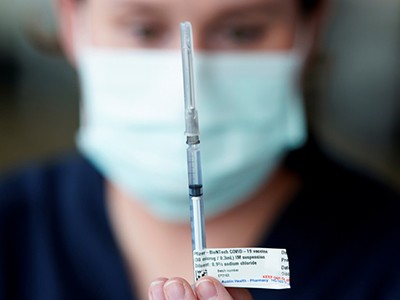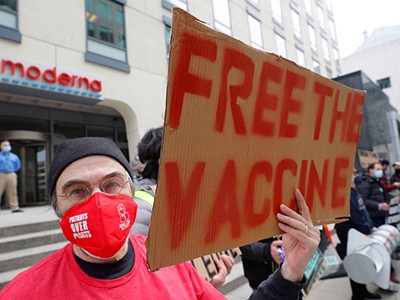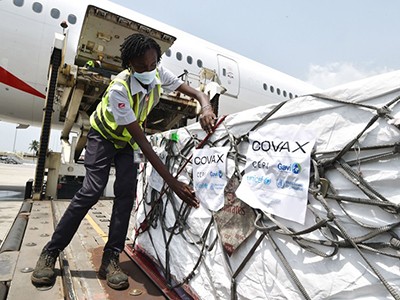
Coronavirus research at the Pasteur Institute in Dakar, Senegal. The institute is one of only ten (existing and planned) vaccine manufacturing sites across Africa.Credit: Seyllou/AFP/Getty
A continent of 1.2 billion people should not have to import 99% of its vaccines. But that is the tragic reality for Africa. Fixing the lack of home-grown manufacturing capacity has become a top priority for Africa’s policymakers. Last week, 40,000 people, including researchers, business leaders and members of civil-society groups, joined heads of state for a two-day online summit designed to share the latest developments and kick-start fresh thinking on how to bring vaccine manufacturing to Africa.
For more than a century, vaccine research and development (R&D) and manufacturing have been concentrated in Europe, India and the United States. Amid a raging pandemic, one result of this is that people in low- and middle-income countries might have to wait until the end of 2023 before they can be vaccinated against COVID-19. This is simply unacceptable.
Delegates at last week’s summit vowed to accelerate plans to boost the continent’s vaccine manufacturing, research and regulatory capacity. They endorsed a proposal for 60% of Africa’s routinely used vaccines to be made in Africa within 20 years, and agreements were signed with international organizations representing companies and donor agencies. But achieving this goal will need some hard conversations in the weeks and months ahead.
Why a pioneering plan to distribute COVID vaccines equitably must succeed
One such conversation must be on the need for sustained and long-term investment, especially in domestic R&D, as a vaccines industry cannot be created without this. In spite of the best efforts of researchers such as the late Calestous Juma, who founded the African Centre for Technology Studies in Nairobi, most governments, for a variety of reasons, pushed back against the idea that domestic R&D is of long-term value. It needed a pandemic to persuade Africa’s leaders to be convinced of the case for bigger investments. That is to be welcomed — but it will need more than warm words at a conference to provide assurance that the plans being hatched will come to fruition.
There will also need to be hard conversations with donor countries, their pharmaceutical companies, and funders and researchers — essentially, all those currently involved in supplying Africa with vaccines. If the goal is now African self-sufficiency in what some call the vaccine ‘value chain’, then international partnerships with the continent’s institutions will require a different approach. A partnership in which the objective is to empower the continent’s own researchers and businesses will need to be different from existing partnerships, in which the objective is to supply Africa with vaccines. Some international companies might regard African self-sufficiency as a long-term risk to their business; some might fear a loss of influence. Firms and researchers from outside Africa shouldn’t take this view if they agree that a genuine partnership of equals is in everyone’s interests. Vaccines are essential to public health. And public health is essential to strong economies.
Unity of purpose
Creating a new industry needs a strategy, and investment. Equally important will be unity of purpose. This means that Africa’s main governance bodies — those representing politics and diplomacy; finance; and research — all need to be on the same page, something that cannot be over-emphasized. Doing anything on an Africa-wide scale necessarily takes time, as it requires consultations between citizens of more than 50 countries, their leaders, as well as institutions — including the African Union Commission, the Africa Centres for Disease Control and Prevention (CDC) and the African Development Bank. It was forward-thinking of the African Union and Africa CDC to have an open invitation to their two-day summit. But there must be unity between the institutions that will make decisions on the main priorities, and some consensus on how to achieve these priorities.
In other respects, the pace of progress needs to accelerate. Take vaccines regulation. Six years ago, African countries agreed to establish an African Medicines Agency (AMA). This would be analogous to the European Medicines Agency, based in Amsterdam, and would make recommendations on the safety and efficacy of new drugs and vaccines, shortening the time that national regulators would need to approve such products.
What it will take to vaccinate the world against COVID-19
A treaty to create the AMA was adopted by the African Union in 2019, but it needs a minimum of 15 nations to ratify it before the AMA can officially exist. As of last year, eight countries have done so, a sign that most did not see it as a priority before the pandemic. That must change, and more countries need to quickly organize ratification.
Intellectual property (IP) is another hurdle. More than 100 mostly low- and middle-income countries are asking richer countries for a temporary waiver on IP related to COVID-19 vaccines, so they can ramp up their own manufacturing. But high-income countries favour technology-transfer arrangements in which their pharmaceutical companies share know-how, tools and skills through a trusted third party, such as the World Health Organization. In the past, this approach has had some success in creating vaccine-making capacity in middle-income countries.
Some argue that the IP issue should be kept separate from Africa’s vaccine-manufacturing ambitions, but the reality is that they are closely linked. Some governments are studying the feasibility of making vaccines based on mRNA technology, which is behind two of the major COVID-19 vaccines being rolled out across the world. But whichever of the existing vaccine technologies are deployed, patent holders will need to be consulted and appropriately compensated. That bottleneck is one reason why the idea of a temporary IP waiver for the duration of the pandemic has become popular, and needs to happen. If properly organized, and an agreed process is followed, it will allow countries to quickly get on the first few rungs of the vaccine-manufacturing ladder.
It’s time to consider a patent reprieve for COVID vaccines
Scientists in the public and private sectors have an important part to play here. They have been central to vaccines research, laboratory testing, clinical trials, evaluation, regulation and roll-out. Researchers have relationships with almost everyone involved. Understandably, and often for good reasons, researchers mostly avoid becoming involved in policy or diplomatic debates, such as whether a temporary IP waiver should be granted. But if the pandemic continues on an exponential path, the arguments for holding on to COVID-19 IP will become harder to defend — and researchers have the influence and knowledge to change the debate.
Vaccines as public goods
How could researchers become involved? There aren’t many examples to fall back on, but the food crises of the late 1960s offer some lessons. Back then, researchers were starting to develop high-yielding crop varieties through what became known as Green Revolution agriculture. The challenge was how to bring the new technologies into the mainstream. As Lowell Hardin, one of the scientists behind the Green Revolution, wrote in a Nature series published in 2008 called ‘Meetings that changed the world’, researchers needed to convince governments and aid donors that the technologies could have world-changing consequences — but also that they would remain in the public domain (see go.nature.com/3armkuv). The idea that agricultural technologies were public goods, and should be shared widely, was central to the Green Revolution. Another rationale was that there should not be profiteering from developing technologies that would be used to feed hungry people.
How COVID spurred Africa to plot a vaccines revolution
Of course, that was a different time. It was before a landmark law was passed in the United States, the 1980 ‘Bayh-Dole Act’, which opened the door to universities commercializing their discoveries; and before another landmark decision, a US Supreme Court ruling of the same year, in which the first patent on a genetically modified organism was granted. Both these developments mean that, today, it is more difficult for researchers to argue that technologies should be treated as public goods. But that doesn’t mean they shouldn’t try. It should be possible to find a way to compensate inventors while building national R&D capacity, and keeping life-saving technologies in the public domain. If this principle can be agreed upon, the task will be easier.
The world’s researchers have created, and continue to create, innovative vaccines. But it is now time to grow and share this knowledge with colleagues in under-served regions, especially in Africa. Their intervention in Africa’s vaccine-manufacturing ambitions might well be too late to make a difference during the present pandemic, but it will almost certainly help to ensure that the continent’s people are much better protected during the next.

 How COVID spurred Africa to plot a vaccines revolution
How COVID spurred Africa to plot a vaccines revolution
 What it will take to vaccinate the world against COVID-19
What it will take to vaccinate the world against COVID-19
 It’s time to consider a patent reprieve for COVID vaccines
It’s time to consider a patent reprieve for COVID vaccines
 Why a pioneering plan to distribute COVID vaccines equitably must succeed
Why a pioneering plan to distribute COVID vaccines equitably must succeed
 The WHO’s chief scientist on a year of loss and learning
The WHO’s chief scientist on a year of loss and learning
 Bellagio 1969: The green revolution
Bellagio 1969: The green revolution






